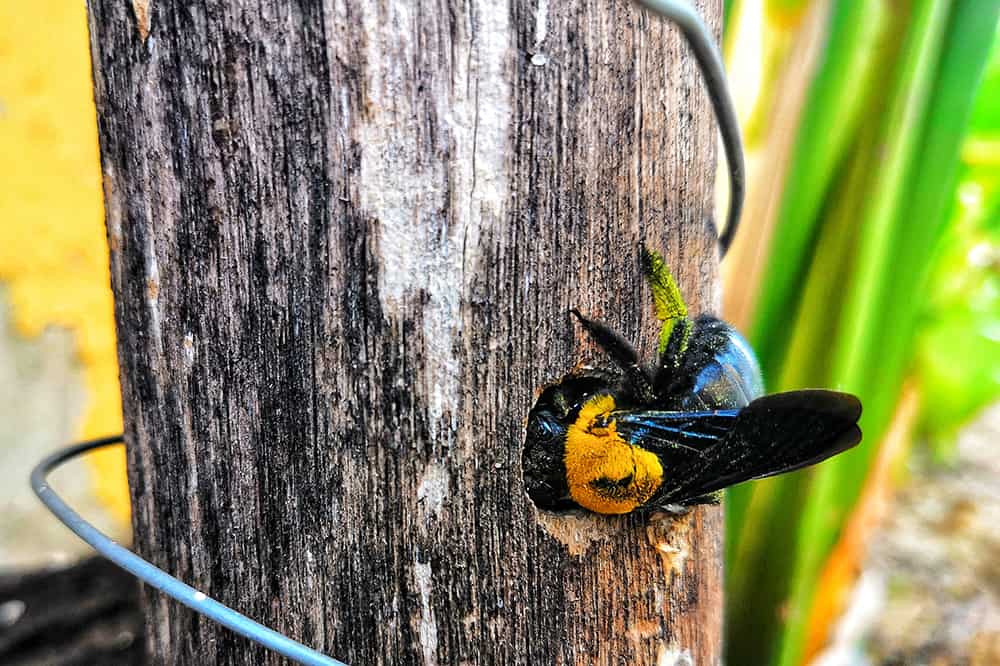First of all, in the spring of the year you may notice what looks like bumble bees flying around your homes eaves and soffits. You may also see them flying around wood fences and wood frame windows. There is a good chance you have carpenter bees instead of bumble bees.
Carpenter bees do not eat wood but will hollow out tunnels in wood to create a gallery to lay eggs. Furthermore, these bees will normally attack dead tree limbs in the forest but can’t tell the difference between a limb or your wood roof eave.
There are about 28 species of carpenter bees in the United States. They vary in size and habits. The smaller species may not be as noticeable because of their size. One of the larger species is the eastern carpenter bee.
Carpenter Bee In Tennessee
In Tennessee the larger eastern carpenter bee species and the common eastern bumble bee look very much alike. Both have yellow and black coloration. The bumble bee has hair covering most of the body including the abdomen. The carpenter bee is larger and has a black hairless abdomen. Unlike the bumble bee carpenter bees are considered a solitary bee. A male and a female will build a single nest or brood chamber in wood where eggs are laid to develop into adults.
Bumble bees have a more social colony set up with numerous bee members.
Both of these bees are excellent pollinators.
Eastern Carpenter Bees
The eastern carpenter bees is very common and can be seen buzzing around roof eaves and wood fences in March, April and May. They create chambers in wood to lay eggs that develop into new bees.
They create these galleries in dead tree limbs or wood associated with structures like wood decks, soffit boards, eaves or wood fences.
Carpenter Bee – Female Vs. Male
The female carpenter bee can sting and the male cannot. They mate in the spring and begin to create a gallery in wood for the female to lay eggs.
Carpenter bees do not consume wood but bore a hole into wood to create a gallery to lay eggs. The female will begin to bore a dime size hole into the wood surface. This gallery tunnel will normally go in about one inch and them take a right angle turn to follow the grain of the wood.
The male carpenter bee does not sting. It will stand guard around the exterior of the entrance hole and buzz any anything or any body that comes near.
After the chamber is bored out the female will create a chamber and lay a single egg along with a ball of pollen and nectar for the developing larva to feed on. The female when seals the chamber and proceeds to create another chamber with egg and food. She will create another five to seven egg cells to complete the task.
Some interesting facts about carpenter bees:
- The male carpenter bee cannot sting but can bite if held.
- After the egg chambers are created and eggs laid the adults usually die within a few weeks.
- The newly emerged adults will be attracted back to the bored out egg chambers in the fall to over winter.
Metamorphosis of the Carpenter Bee
The carpenter bee egg will develop by complete metamorphosis composing an egg, larvae, pupae and then to an adult. The new adults will emerge from the egg chambers later in the summer to feed on nectar and pollen.
These new adults will feed until the chill of fall and then seek out carpenter bee egg chamber holes created in the spring. They will move into these chambers for protection to over winter until spring.
In the spring they will emerge ready to mate. They will create new chambers and possibly more damage to the structure.
This is the reason you will see more carpenter bees in damaged wood areas every year.
Pollinator And Wood Destroying Insect
Finally, carpenter bees are good pollinators but become wood destroying insects when they invade your home and cause damage. A good coat of paint or oil based stain can deter the bees from attacking non-infested wood. One the wood area is infested it is hard to stop re-infesting without treatments.
The best way to prevent damage is to treat the wood areas in the early spring at the first sign of the bees. Once the holes are established an insecticide dust may be applied into the holes. In addition, during the late summer months, seal all holes to prevent bees from over-wintering.
Connect With U.S. Pest
As a result, keep up with the latest pest news at uspestnews.com. Connect and follow us on social media! Facebook | Twitter | Instagram | LinkedIn or YouTube. Need our services? Contact Us today!


